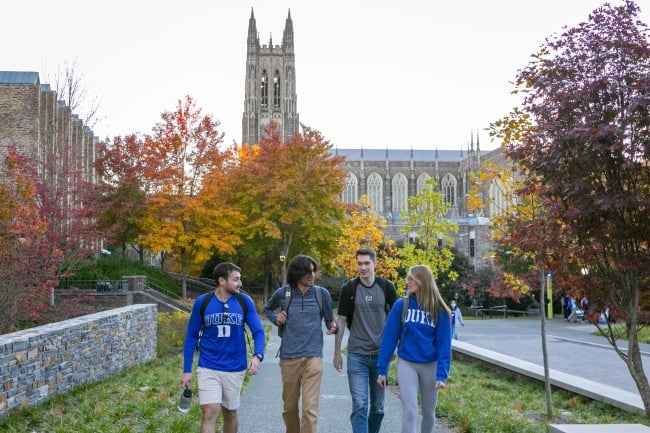You have /5 articles left.
Sign up for a free account or log in.

Duke University is offering full tuition grants to low-income students from the Carolinas this fall. With the Supreme Court set to rule on affirmative action, it could also be a play for more diverse applicants.
Duke University file photo
Duke University announced last week that it would offer full tuition grants starting this fall to students from North and South Carolina whose family income is less than $150,000.
The new financial aid policy is notable not just for its high income cap and geographic specificity, but also for its timing. It comes in the midst of a weeks-long period of collective anticipation regarding the Supreme Court’s ruling in two cases that will determine the fate of affirmative action.
Expectations that the conservative-majority court will ban the practice have sent selective institutions scrambling to brainstorm alternative strategies to ensure the diversity of their student bodies doesn’t plummet.
Christoph Guttentag, Duke’s dean of admissions since 1996, said the primary purpose of the policy is to improve accessibility to what is arguably the most elite private university in the Carolinas. The median family income for Duke students is $186,700; more than two-thirds come from families in the top 20 percent of income earners and a fifth from the top 1 percent—a higher proportion than almost any other college in North Carolina, according to data from The New York Times.
While Guttentag didn’t make a direct connection to the looming Supreme Court decision, he said he hopes the new tuition plan has a knock-on effect on diversity in admissions and recruitment.
“I expect that it will lead a significant number of students and families who thought the cost of attendance was an insurmountable barrier to think about Duke seriously as a college option,” he said.
Richard Kahlenberg, a nonresident scholar at Georgetown University’s Center on Education and the Workforce, surmised that the timing was too convenient to be mere coincidence, noting that the plan has the potential to provide an alternative path to diversity.
“The timing certainly suggests this is related to the Supreme Court decision,” he said. “I think, increasingly, financial aid policies will be intertwined with admissions and recruitment, since one of the important ways to increase diversity by race in the absence of race-based admissions is to do a better job of recruiting working-class students.”
An Affirmative Action Alternative?
When asked if the decision was connected to the forthcoming Supreme Court decision, Guttentag was mindful of the legal minefield in front of him: “I’m imagining university counsel standing over me right now,” he said. But even as he highlighted the socioeconomic focus of Duke’s plan, he did not deny its potential downstream effects if the court bans race-conscious admissions, as many expect.
“I anticipate there will be additional challenges in recruiting and enrolling diverse classes … how different colleges including Duke will be able to respond, that remains to be seen,” he said. “We’re doing this for the most straightforward of reasons, which is affordability and access. But diversity is not one-dimensional. It manifests in various and interconnected ways, so any additional benefits we’d be grateful for.”
Mark Long, dean of the school of public policy at the University of California, Riverside, said university officials like Guttentag need to be especially careful when discussing how new admissions and recruitment policies might relate to racial diversity efforts, given that those may soon be illegal. Still, while he believes Duke’s accessibility rationale, he said he wouldn’t be surprised if there was more to the story.
“It’s going to be a delicate dance universities have to do, whether or not they intend some policy as a response [to the court decision],” said Long, who has researched affirmative action alternatives in states that have banned race-conscious admissions. “But plenty of other factors have stood in as proxies [for affirmative action], and income is at the forefront of some of those discussions … It’s probably not the only reason [Duke] is doing this, but it could fit into a broader constellation of efforts that don’t directly address race.”
“Race-neutral” admissions strategies—including doing away with standardized test requirements, which heavily favor white applicants—have largely dominated the discussion of affirmative action alternatives. But research suggests such initiatives are not enough to make up for losses in diverse student enrollment.
Kahlenberg said financial aid solutions have the potential to boost diversity in recruitment at selective institutions. But he added that an equal commitment has to be made on the admissions side in order for the approach to work.
“Admissions and financial aid are two essential pieces to creating economic and racial diversity. In selective colleges, you can’t have one without the other,” he said. “If you admit very few low-income students, you can have the most generous financial aid program in the world and still not generate economic diversity.”
Duke waived its standardized test requirement in 2020, which Guttentag said ushered in a “tsunami” of more diverse applicants. He hopes the tuition grants have a similar, if more localized, effect on the applicant pool.
“The impact of [going test optional], in terms of the number of applications, exceeded what many of us anticipated,” he said. “I don’t know that this [decision] will have the same effect, but based on the number of phone calls and emails our office and the financial aid office have gotten, this has really struck a chord with Carolinians.”
Kahlenberg, who has spent years advocating for a class-focused form of affirmative action, said he believes a federal ban on affirmative action—or even the threat of it—could lead to more socioeconomic-based admissions and accessibility policies like Duke’s.
“A conservative Supreme Court decision on race will, paradoxically, prompt a number of liberal policy initiatives,” he said. “If the only legal way to promote racial diversity becomes increasing socioeconomic and geographic diversity, then universities are going to have to do what they should have, in my view, done a long time ago.”
Competing for Talent ‘in Our Backyard’
Other potential motives for Duke’s decision include competing for high-achieving students in the region, many of whom choose to go either to an elite school in the Northeast or California or to an in-state public institution like the University of North Carolina at Chapel Hill, where the cost of tuition is almost $25,000 cheaper.
“Many students really want to leave home to go to college, and beyond that we are competing with excellent state universities in North and South Carolina,” Guttentag said. “The extent to which this helps us attract students who might otherwise go elsewhere, that’s certainly an important goal.”
Duke already enrolls more students from North Carolina than any other state—they make up about 16 percent of the student body, or 1,131 students, according to university spokesperson Greg Phillips; South Carolinians make up a much smaller portion, with only 161 students. Phillips was unable to provide demographic or socioeconomic breakdowns for those groups in time for publication.
Guttentag said the tuition grants are meant to create pathways for students in the Carolinas, the less well-off of whom may be more likely to benefit from a Duke education.
“North and South Carolina are our backyard,” Guttentag said. “There’s such diversity within these states—I mean, pretty much the entire range of experience that a college is looking for can be found in the Carolinas, and we’re really excited about our ability to draw a wider range of students from here.”
Long said this belies a kind of competition among the elite institutions to which Duke belongs. Princeton and Harvard Universities, for example, offer free tuition to any student whose family income is $75,000 or less; Stanford raised its cap for free tuition, as well as room and board, from $75,000 to $100,000 in February. (This paragraph has been updated to reflect the extent of Stanford's aid.)
“If your comparison schools are engaging in these kinds of practices perceived to be socially appropriate, then if you’re the one not doing it, you stand out,” he said.
Kahlenberg was intrigued by Duke’s $150,000 income cap, which is higher than at most selective institutions. He said the decision to widen the eligibility pool reflected an understanding of not just income disparity but also wealth gaps, which in the South are particularly pronounced among Black families.
“Because of our history of slavery, segregation and redlining, even middle-class or upper-middle-class Black families don’t often have much wealth,” he said. “People may think that a big grant program going as high as $150,000 is not helping students who need it most. But what that misses is the middle-class Black students from low-wealth families who deserve a break.”
Kahlenberg said that even if affirmative action wasn’t the impetus for Duke’s plan, its specifics and clarity could make it uniquely suited to attract high-achieving applicants of color who are likely to attend.
“This is a high-profile way to attract more students from the Carolinas who could add diversity, by removing any doubt about what they would have to pay for college,” he said. “And because the Carolinas, and the South in general, have a much larger share of Black students than the rest of the country, geographic overlay to that financial aid policy can have a big impact on racial diversity.”
Whatever the true impetus of Duke’s plan and its conspicuous timing, it may be just the first of a range of innovative recruitment strategies to emerge in the face of the Supreme Court’s decision.
“We are all committed to maintaining diverse classes; that’s one of the ways we measure our success, and I don’t think that’s going to change,” Guttentag said. “But right now every dean and director of admissions, every vice president for enrollment is speaking with their university counsel to understand what is appropriate and helpful public language, to determine how we can express our values without breaking any laws.”









